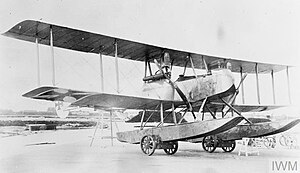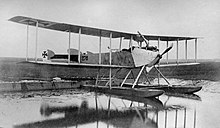Gotha WD.7: Difference between revisions
| Line 42: | Line 42: | ||
[[File:Gotha_WD.7_3-view_Aviation_and_Aeronautical_Engineering_September_15,1916.png|alt=|thumb|Gotha WD.7 3-view drawing from ''Aviation and Aeronautical Engineering'' September 15, 1916]] |
[[File:Gotha_WD.7_3-view_Aviation_and_Aeronautical_Engineering_September_15,1916.png|alt=|thumb|Gotha WD.7 3-view drawing from ''Aviation and Aeronautical Engineering'' September 15, 1916]] |
||
{{Aircraft specs |
{{Aircraft specs |
||
|ref=Gotha Aircraft of WWI: A Centennial Perspective on Great War Airplanes;<ref |
|ref=Gotha Aircraft of WWI: A Centennial Perspective on Great War Airplanes;<ref>Herris, pp. 45, 48</ref> German Aircraft of the First World War<ref name=Gray>Gray & Thetford, p. 400</ref> |
||
|prime units?=met |
|prime units?=met |
||
<!-- |
<!-- |
||
| Line 56: | Line 56: | ||
|length note=<br/> |
|length note=<br/> |
||
::::'''WD.8:''' {{cvt|11.2|m}} |
::::'''WD.8:''' {{cvt|11.2|m}} |
||
|span m= |
|span m= |
||
|span ft= |
|span ft= |
||
|span in= |
|span in= |
||
| Line 63: | Line 63: | ||
|upper span ft= |
|upper span ft= |
||
|upper span in= |
|upper span in= |
||
|upper span note= |
|upper span note=</br> |
||
| ⚫ | |||
|lower span m=14.8 |
|lower span m=14.8 |
||
|lower span ft= |
|lower span ft= |
||
| Line 71: | Line 72: | ||
|height ft= |
|height ft= |
||
|height in= |
|height in= |
||
|height note= |
|height note=<br/> |
||
::::'''WD.8:''' {{cvt|4.1|m}} |
|||
|wing area sqm=55.5 |
|wing area sqm=55.5 |
||
|wing area sqft= |
|wing area sqft= |
||
|wing area note= |
|wing area note= |
||
| ⚫ | |||
|airfoil= |
|airfoil= |
||
|empty weight kg=1275 |
|empty weight kg=1275 |
||
|empty weight lb= |
|empty weight lb= |
||
|empty weight note=<br/> |
|empty weight note=<br/> |
||
::::'''WD.8:''' {{cvt| |
::::'''WD.8:''' {{cvt|1254|kg}} |
||
|gross weight kg=1785 |
|gross weight kg=1785 |
||
|gross weight lb= |
|gross weight lb= |
||
|gross weight note=< |
|gross weight note=</br> |
||
::::'''WD.8:''' {{cvt| |
::::'''WD.8:''' {{cvt|1778|kg}} |
||
|max takeoff weight kg= |
|max takeoff weight kg= |
||
|max takeoff weight lb= |
|max takeoff weight lb= |
||
| Line 114: | Line 115: | ||
|max speed kts= |
|max speed kts= |
||
|max speed note=<br/> |
|max speed note=<br/> |
||
::::'''WD.8:''' {{cvt| |
::::'''WD.8:''' {{cvt|138|km/h|mph kn}} |
||
|max speed mach=<!-- supersonic aircraft --> |
|max speed mach=<!-- supersonic aircraft --> |
||
|range km=475 |
|range km=475 |
||
|range miles= |
|range miles= |
||
|range nmi= |
|range nmi= |
||
|range note= |
|range note=</br> |
||
::::'''WD.8:''' {{cvt|480|km}} |
|||
|combat range km= |
|combat range km= |
||
|combat range miles= |
|combat range miles= |
||
| Line 138: | Line 140: | ||
|time to altitude=9.5 minutes to {{cvt|1000|m}} |
|time to altitude=9.5 minutes to {{cvt|1000|m}} |
||
:::::*40 minutes to {{cvt|2000|m}} |
:::::*40 minutes to {{cvt|2000|m}} |
||
::::'''WD.8:''' 6.5 minutes to 1000 m |
|||
|sink rate ms=<!-- sailplanes --> |
|||
:::::* 25 minutes to {{cvt|2500|m}} |
|||
|sink rate ftmin=<!-- sailplanes --> |
|||
|sink rate note= |
|||
|lift to drag= |
|lift to drag= |
||
|wing loading kg/m2= |
|wing loading kg/m2= |
||
Revision as of 17:43, 21 March 2024
| WD.7 and WD.8 | |
|---|---|

| |
| A forward oblique view of a WD.7 on its beaching trolleys | |
| Role | Maritime reconnaissance aircraft and torpedo-bomber trainer |
| National origin | Germany |
| Manufacturer | Gothaer Waggonfabrik |
| First flight | December 1915 |
| Primary user | Imperial German Navy |
| Number built | 8 x WD.7; 1 x WD.8 |
The Gotha WD.7 (Wasser Doppeldecker - "Water Biplane") was a twin-engine maritime patrol and torpedo-bomber training floatplane developed during World War I by Gothaer Waggonfabrik for the Imperial German Navy's (Kaiserliche Marine) Naval Air Service (Marine-Fliegerabteilung). The WD.8 was a single-engine version of the WD.7 developed for comparative purposes. The single aircraft built was deemed "totally unsuitable" by the Naval Air Service and was later sold to the Ottoman Empire.
Development
After the submarine SM U-9 sank three British armored cruisers on 22 September 1914 shortly after the war began, the German Imperial Naval Office (Reichsmarine-Amt) decided to try mounting torpedoes on aircraft as they were far easier and faster to build than submarines. Early trials with land-based aircraft were unsuccessful because of the great weight of the torpedo (645 kilograms (1,422 lb)) was more than existing aircraft could easily lift and the danger of trying to fly from an uneven grass airstrip with such a large weight of explosives. At the beginning of 1915 the Naval Office ordered the development of seaplanes capable of carrying torpedoes and the Seaplane Experimental Command (Seeflugzeug-Versuchs-Kommando (SVK)) issued requirements for these aircraft. They had to be twin-engine airplanes armed with a machine gun for self-defense and with a crew of two or three men: a pilot and observer for torpedo missions and a pilot, bombardier and gunner for bombing missions.[1]
After the pusher-configuration WD.3 was rejected by the SVK, Gotha turned to a new layout that would keep the aircraft's nose free for forward-firing weapons. The WD.7 therefore, was a tractor-configuration biplane with 120-horsepower (89 kW) Mercedes D.II straight-six engines mounted on the leading edge of the lower wing. The radiators were located above each engine. The aircraft did retain the WD.3's nose and gunner's cockpit in addition to the twin-tail tail structure. The prototype kept the central vertical stabilizer as well, but this was eliminated in the production aircraft.[2]
Eight examples were built for use as trainers for torpedo bombing. During 1917, two of these aircraft were used for testing a 37 mm (1.46 in) autocannon built by DWM.

The same airframe was used to create the WD.8 reconnaissance floatplane, substituting the two wing-mounted engines with a single water-cooled 240-horsepower (180 kW) Maybach Mb.IVa straight-six engine in the nose.
Variants
- WD.7
- twin-engine torpedo bomber trainer floatplane, powered by two 120 hp (89 kW) Mercedes D.II.[3]
- WD.8
- single-engine reconnaissance floatplane, powered by a 240 hp (180 kW) Maybach Mb.IV.[3]
Specifications (WD.7 prototype)

Data from Gotha Aircraft of WWI: A Centennial Perspective on Great War Airplanes;[4] German Aircraft of the First World War[3]
General characteristics
- Crew: 3
- Length: 11.3 m (37 ft 1 in)
- WD.8: 11.2 m (37 ft)
- Upper wingspan: 16.8 m (55 ft 1 in)
- WD.8: 16 m (52 ft)
- Lower wingspan: 14.8 m (48 ft 7 in)
- Height: 3.9 m (12 ft 10 in)
- WD.8: 4.1 m (13 ft)
- Wing area: 55.5 m2 (597 sq ft)
- Empty weight: 1,275 kg (2,811 lb)
- WD.8: 1,254 kg (2,765 lb)
- Gross weight: 1,785 kg (3,935 lb)
- WD.8: 1,778 kg (3,920 lb)
- Powerplant: 2 × Mercedes D.II water-cooled straight-six engines, 89 kW (120 hp) each
- Propellers: 2-bladed
Performance
- Maximum speed: 128 km/h (80 mph, 69 kn)
- WD.8: 138 km/h (86 mph; 75 kn)
- Range: 475 km (295 mi, 256 nmi)
- WD.8: 480 km (300 mi)
- Service ceiling: 3,500 m (11,500 ft)
- WD.8: 4,500 m (14,800 ft)
- Time to altitude: 9.5 minutes to 1,000 m (3,300 ft)
- 40 minutes to 2,000 m (6,600 ft)
- WD.8: 6.5 minutes to 1000 m
- 25 minutes to 2,500 m (8,200 ft)
Armament
- Guns: 1 x 7.92 mm (0.312 in) Parabellum MG 14 in the forward cockpit
- WD.8: 1 x 7.62 mm Parabellum MG 14 machine gun in the rear cockpit
References
Bibliography
- Gray, Peter & Thetford, Owen (1987) [1970]. German Aircraft of the First World War (2nd ed.). London: Putnam. ISBN 0-85177-809-7.
- Herris, Jack (2013). Gotha Aircraft of WWI: A Centennial Perspective on Great War Airplanes. Great War Aviation Centennial Series. Vol. 6. Charleston, South Carolina: Aeronaut Books. ISBN 978-1-935881-14-8.
- Metzmacher, Andreas (2021). Gotha Aircraft 1913–1954: From the London Bomber to the Flying Wing Jet Fighter. Brimscombe, Stroud: Fonthill. ISBN 978-1-78155-706-8.
- Nowarra, Heinz J.; Robertson, Bruce & Cooksley, Peter G. (1966). Marine Aircraft of the 1914–1918 War. Letchworth, UK: Harleyford Publications. OCLC 123198808.
- Schmeelke, Michael (2020). "Torpedo Los!": The German Imperial Torpedo-Flieger. n.p.: Aeronaut Books. ISBN 978-1-953201-17-1.
- Schmeelke, Michael (2018). Zeebrugge: Naval Air Station Flanders I 1914–1918. Reno, Nevada: Aeronaut Books. ISBN 978-1-935881-46-9.
